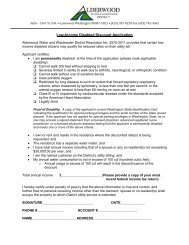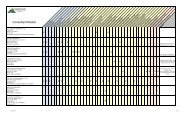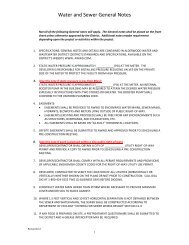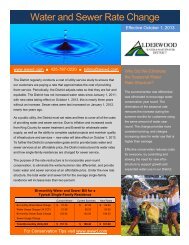alderwood water & wastewater district snohomish county ...
alderwood water & wastewater district snohomish county ...
alderwood water & wastewater district snohomish county ...
You also want an ePaper? Increase the reach of your titles
YUMPU automatically turns print PDFs into web optimized ePapers that Google loves.
ALDERWOOD WATER & WASTEWATER DISTRICTSNOHOMISH COUNTY, WASHINGTONRESOLUTION NO. 2567·2010A RESOLUTION of the Board of Commissioners of the Alderwood Water andWaste<strong>water</strong> District, Snohomish County, Washington, establishing a writtenCross-Connection Control Progra'm,and repealing Resolution No. 2385-2000.WHEREAS, it is the <strong>water</strong> purveyor's responsibility to provide <strong>water</strong> to thecOnsumer that meets Washington State <strong>water</strong> quality standards; andWHEREAS, it is the <strong>water</strong> purveyor's responsibility to prevent the contaminationof the public <strong>water</strong> supply system; andWHEREAS, cross-connections within the consumer's plumbing system pose apotential source of contamination of the public <strong>water</strong> supply system; andWHEREAS, pursuant to WAC 246-290-490 and other state laws and regulations,the District, the consumer, the Washington State Department of Health, and the localauthority having jurisdiction over enforcement of the Uniform Plumbing Code, asadopted in Washington, each have responsibilities relating to controlling crossconnections;andWHEREAS, pursuant to WAC 246-290-490, the District desires to provide a clearand uniform policy regarding these responsibilities and the District's enforcement ofsuch policy;NOW, THEREFORE, BE IT RESOLVED that the Board of Commissioners of theAlderwood Water & Waste<strong>water</strong> District, Snohomish County, Washington, establishesthe following <strong>water</strong> service connection policy to protect the public <strong>water</strong> supply systemfrom the risk of contamination from consumer <strong>water</strong> systems. For public health andsafety, this policy shall apply equally to all new and existing consumers.AWWD Resolution No. 2567-2010 - 1, - December 20,2010
DEFINITIONS:"Approved air gap" means a physical separation between the free-flowing end of apotable <strong>water</strong> supply pipeline and the overflow rim of an open or nonpressurizedreceiving vessel."Approved backflow preventer" means an approved air gap, an approved backflowprevention assembly, or an approved AVB. The terms "approved backflow preventer,""approved air gap," or "approved backflow prevention assembly" refer only to thoseapproved backflow preventers relied upon by the purveyor for the protection of thepublic <strong>water</strong> system. The requirements of WAC 246-290-490 do not apply to backflowpreventers installed for other purposes."Approved backflow prevention assembly" means an RPBA, RPDA, DCVA, DCDA,PVBA, or SVBA of make, model, and size that is approved by the department.Assemblies that appear on the current approved backflow prevention assemblies listdeveloped by the University of Southern California Foundation for Cross-ConnectionControl and Hydraulic Research or other entity acceptable to the department areconsidered approved by the department."Authority having jurisdiction" (formerly known as local administrative authority)means the local official, board, department, or agency authorized to administer andenforce the provisions of the Uniform Plumbing Code as adopted under chapter 19.27RCW."Backflow" means the undesirable reversal of flow of <strong>water</strong> or other substancesthrough a cross-connection into the public <strong>water</strong> system or consumer's potable <strong>water</strong>system."Board of Commissioners" or "The Board" means those people elected to overseethe affairs of the Alderwood Water & Waste<strong>water</strong> District."Consumer" means any person receiving <strong>water</strong> from a public <strong>water</strong> system from eitherthe meter, or the point where the service line connects with the distribution system if nometer is present. For purposes of cross-connection control, "consumer" means theowner or operator of a <strong>water</strong> system connected to a public <strong>water</strong> system through aservice connection."Consumer's <strong>water</strong> system," as used in WAC 246-290-490, means any potable orindustrial <strong>water</strong> system that begins at the point of delivery from the public <strong>water</strong> systemand is located on the consumer's premises. The consumer's <strong>water</strong> system includes allauxiliary sources of supply, storage, treatment, and distribution facilities, piping,plumbing, and fixtures under the control of the consumer."Cross-connection" means any actual or potential physical connection between apublic <strong>water</strong> system orthe consumer's <strong>water</strong> system and any source of nonpotableliquid, solid, or gas that could contaminate the potable <strong>water</strong> supply by backflow.AWWD Resolution No. 2567-2010 -2- December 20,2010
"Cross-connection control program" means the administrative and technicalprocedures the purveyor implements to protect the public <strong>water</strong> system fromcontamination via cross-connections as required in WAC 246-290-490."Cross-connection control specialist" means a person holding a valid CCScertificate issued under chapter 246-292 WAC."Distribution system" hleans all piping components of a public <strong>water</strong> system thatserve to convey <strong>water</strong> from transmission mains linked to source, storage and treatmentfacilities to the consumer excluding individual services."Domestic <strong>water</strong> service connection" means a service hookup to a property that iscontiguous to a <strong>water</strong> distribution main and where additional distribution mains orextensions are not needed to provide service."Emergency" means an unforeseen event that causes damage or disrupts normaloperations and requires immediate action to protect public health and safety."High health cross-connection hazard" means a cross-connection involving anysubstance that could impair the quality of potable <strong>water</strong> and create an actual publichealth hazard through injury, poisoning, or spread of disease."In-premises protection" means a method of protecting the health of consumersserved by the consumer's potable <strong>water</strong> system, located within the property lines of theconsumer's premises by the installation of an approved air gap or backflow preventionassembly at the point of hazard, which is generally a plumbing fixture."Potable" means <strong>water</strong> suitable for drinking by the public."Premises isolation" means a method of protecting a public <strong>water</strong> system byinstallation of approved air gaps or approved backflow prevention assemblies at or nearthe service connection or alternative location acceptable to the purveyor to isolate theconsumer's <strong>water</strong> system from the purveyor's distribution system."Public <strong>water</strong> supply system" shall mean any system providing <strong>water</strong> for humanconsumption through pipes or other constructed conveyances, excluding a systemserving only one single-family residence and a system with four or fewer connections allof which serve residenc
clearly defined single family residences, the following formulas shall be used indetermining the number of services to be included as residential connections on theWFI form."Severe health cross-connection hazard" means a cross-connection which couldimpair the quality of potable <strong>water</strong> and create an immediate, severe public healthhazard through poisoning or spread of disease by contaminants from radioactivematerial processing plants, nuclear reactors, or waste<strong>water</strong> treatment plants."Source <strong>water</strong>" means untreated <strong>water</strong> that is not subject to recontamination bysurface runoff."Uniform Plumbing Code (UPC)" means the code adopted under RCW 19.27.031 (4)and implemented under chapter 51-56 WAC. This code establishes statewide minimumplumbing standards applicable within the property lines of the consumer's premises.ABBREVIATIONS"AG" means Air Gap"AVB" means Atmospheric Vacuum Breaker"CCS" means Cross Connection Control Specialist"DCDA" means Double Check Detector Assembly"DCVA" means Double Check Valve Assembly"DOH" means Department of Health"PVBA" means Pressure Vacuum Breaker Assembly"PWS" means Public Water System"RPBA" means Reduced Pressure Backflow Assembly"RPDA" means Reduced Pressure Detector Assembly"SVBA" means Spill Resistant Vacuum Breaker Assembly"WAC" means Washington Administrative Code"WQD" Water Quality DepartmentAWWD Resolution No. 2567-2010 - 4 - December 20, 2010
(i)(ii)(iii)Require the consumer to install an approved backflow preventer forpremises isolation commensurate with the degree of hazard; orInstall, at the consumer's expense, an approved backflow preventerfor premises isolation commensurate with the degree of hazard; orDeny or discontinue <strong>water</strong> service to a consumer's premises u'ntilthe cross-connection hazard is eliminated or controlled to thesatisfaction of the District. Except in the event of an emergency,the District shall notify the authority having jurisdiction prior todenying or discontinuing <strong>water</strong> service to a consumer's premisesfor one or more of the reasons listed above.b. Upon identification of a cross-connection exists that is not controlledcommensurate to the degree of hazard, the District will notify the customerby mailing a letter substantially in the form of Exhibit B.c. Upon determination that a consumer fails to comply with the District'srequirements regarding the installation, inspection, testing, maintenanceor repair of approved backflow preventers, the District will notify thecustomer by mailing a letter substantially in the form of Exhibit C.d. If, after being notified pursuant to Paragraphs 4.b and 4.c above, thecustomer fails to correct the deficiency, then the District will give theconsumer and the authority having jurisdiction notice by mail substantiallyin the form of Exhibit D. If the customer still fails to correct the deficiencywithin ten (10) days, then the District will exercise one or more of itsremedies pursuant to Paragraph 4.a.AWWD Resolution No. 2567-2010 - 6 - December 20,2010
EXHIBIT ACross-Connection Control Program StandardsThe following methods of cross-connection control are considered minimum protectionat the <strong>water</strong> service connection at the property line:1. The public <strong>water</strong> supply to any premise listed under WAC 246-290-490(4)(b)(i)(ii)(iii) (Table 9) shall require an approved air gap(AG) separation or anapproved reduced pressure backflow assembly(RPBA) installed immediatelydownstream of the domestic <strong>water</strong> service connection, prior to any branch connections.....Pnlpedy0 0 D 0 0p- O D 0 D 0IU! lxtureProleclJonI0 D D 0WATERMAIlWATERr.ETERPWSJURISDICTIONDOH RegulationsApply1=,I, "IP1wnIIIIIsolationTABLE 9LOCAL ADMINISTRATIVEAUTHORITY JURISDICTIONBuilding/PlumbingCodes ApplySEVERE* AND HIGH HEALTH CROSS-CONNECTION HAZARD PREMISESREQUIRING PREMISES ISOLATION BY AG OR RPBAAgricultural (farms and dairies)Beverage bottling plantsCar washesChemical plantsCommercial laundries and dry cleanersPremises where both reclaimed <strong>water</strong> and potable <strong>water</strong> are providedFilm processing facilitiesAWWD Resolution No. 2567-2010 - 7 - December 20, 2010
Food processing plantsHospitals, medical centers, nursing homes, veterinary, medical and dentalclinics, and blood plasma centersPremises with separate irrigation systems using the purveyor's <strong>water</strong>supply and with chemical addition+LaboratoriesMetal plating industriesMortuariesPetroleum processing or storage plantsPiers and docks.Radioactive material processing plants or nuclear reactorsSurvey access denied or restrictedWaste<strong>water</strong> lift stations and pumping .stationsWaste<strong>water</strong> treatment plantsPremises with an unapproved auxiliary <strong>water</strong> supply interconnected withthe potable <strong>water</strong> supply+ For example, parks, playgrounds, golf courses, cemeteries, estates, etc.* RPBAs for connections serving these premises are acceptable only when used incombination with an in-plant approved air gap; otherwise, the purveyor shall requirean approved air gap at the service connection.2. The public <strong>water</strong> supply to any premise on which material dangerous tohealth or toxic substances are stored or handled, and which, in the assessment of the<strong>district</strong> CCS poses a potential high health cross-connection hazard to the public <strong>water</strong>system, shall require an approved AG separation or an approved RPBA installedimmediately downstream of the domestic <strong>water</strong> service connection, prior to any branchconnections.3. The public <strong>water</strong> supply to any premise where entry is restricted so thatinspection for cross-connections cannot be made with sufficient frequency or atsufficient short notice to assure that cross-connections do not exist shall require anapproved AG separation or an approved RPBA installed immediately downstream of thedomestic <strong>water</strong> service connection, prior to any branch connections.4. The public <strong>water</strong> supply to any premise having a repeated history of crossconnections being established or re-established, shall require an approved AGAWWD Resolution No. 2567-2010 - 8 - December 20,2010
separation or an approved RPBA installed immediately downstream of the domestic<strong>water</strong> service connection, prior to any branch connections.5. The public <strong>water</strong> supply to any premise which has an unapproved auxiliary<strong>water</strong> supply on or available to the consumer's premises that is either not approved forhuman consumption by the health agency having jurisdiction or is not otherwiseacceptable to the purveyor, and with no known cross-connections, shall require anapproved AG separation or an approved RPBA installed immediately downstream of thedomestic <strong>water</strong> service connection, prior to any branch connections.6. The public <strong>water</strong> supply to any premise which has internal crossconnectionsthat are not correctable or which has complex plumbing arrangements thatmake it impractical to ascertain whether or not cross-connections exist, shall require anapproved AG separation or an approved RPBA installed immediately downstream of thedomestic <strong>water</strong> service connection, prior to any branch connections.7. The public <strong>water</strong> supply to any premise which has a heat exchanger or asolar hot <strong>water</strong> system shall require a risk assessment inspection by the <strong>district</strong> WOO todetermine the level of backflow protection that may be required to be installedimmediately downstream of the domestic <strong>water</strong> service connection, prior to any branchconnections.8. The public <strong>water</strong> supply to a fire system which will contain any chemicaladditives, including food-grade additives, shall require an approved RPBA (or RPOA)installed immediately downstream of the public <strong>water</strong> service connection, prior to anybranch connections.9. The public <strong>water</strong> supply to a fire system with no chemical additives shallrequire an approved OCVA (or OCOA) installed immediately downstream of the public<strong>water</strong> service connection, prior to any branch connections.10. The public <strong>water</strong> supply to any premise which poses a high probability ofchanges in the use of <strong>water</strong> by tenants, such as, but not limited to, shopping malls orstrip malls, shall require an approved OCVA installed immediately downstream of thedomestic <strong>water</strong> service connection, prior to any branch connections.11. The public <strong>water</strong> supply to any premise where cross-connections areunavoidable or not correctable, such as, but not limited to, tall buildings (over 30 feet),or <strong>water</strong> booster pump systems, shall require an approved OCVA installed immediatelydownstream of the <strong>water</strong> service connection, prior to any branch connections.AWWD Resolution No. 2567-2010 - 9- December 20,2010
EXHIBIT 8Sample Initial Notice LetterRe:DearCross-Connection Control; Premises Isolation_It has come to our attention thato you do not have a backflow preventero your backflow preventer has not been tested as requiredo your backflow preventer is not functioning properly.This presents a risk of contamination of the District's public <strong>water</strong> supply and is a healthhazard. It is also a violation of the District's Premises Isolation Cross-ConnectionControl Program, which was adopted by District Resolution No., as wellas WAC 246-290-010.Enclosed is an explanation of what is required to correct this deficiency. Pleasetake the necessary corrective action as soon as possible and notify me when it hasbeen completed. If you have any questions, please contact me at (425) 743-4605.Very truly yours,AWWD Resolution No. 2567-2010 - 10- December 20,2010
EXHIBIT CSample Second Notice LetterRe:Cross-Connection Control; Premises IsolationDear --~~--Please refer to our, 20_·, letter regarding your noncompliance withthe District's Cross-Connection Control Program. As we stated,o you do not have a backflow preventero your backflow preventer has not been tested as requiredo your backflow preventer is not functioning properly.This is not only a violation of the District's Program, but also violates WAC 246..290-010and is a potential public health hazard. This is your second notice.The District has the legal authority to enforce the requirement of its CrossConnection Control Program and may, among other things:a. Require the consumer to install an approved backflow preventer forpremises isolation commensurate with the degree of hazard; orb. Install, at the consumer's expense, an approved backflow preventer forpremises isolation commensurate with the degree of hazard; orc. Deny or discontinue <strong>water</strong> service to a consumer's premises until thecross-connection hazard is eliminated or controlled to the satisfaction ofthe District.To avoid an enforcement action, please take the necessary corrective measuresper the enclosed standards within thirty (30) from the date of this notice and notify mewhen it has been completed. If you have any questions, please contact me at (425)743-4605.Very truly yours,AWWD Resolution No. 2567-2010 - 11 - December 20, 2010
EXHIBIT DSample Final Notice LetterRe:Cross-Connection Control; Premises IsolationDear-~--~-Please refer to our , 20_, and ,20_.,lettersregarding your noncompliance with the District's Cross-Connection Control Program.As we stated,o you do not have a backflow preventero your backflow preventer has not been tested as requiredo your backflow preventer ~s not functioning properly.This is not only a violation of the District's Program, but also violates WAC 246"'"290-010and is a potential public health hazard. You still have not rectified the deficiency.The District has the legal authority to enforce the requirement of its CrossConnection Control Program and may, among other things:d. Require the consumer to install an approved backflow preventer forpremises isolation commensurate with the degree of hazard; ore. Install, at the consurner's expense, an approved backflow preventer forpremises isolation commensurate with the degree of hazard; orf. Deny or discontinue <strong>water</strong> service to a consumer's premises until thecross-connection hazard is eliminated or controlled to the satisfaction ofthe District.If you have not completed the necessary corrective measures per the enclosedstandards and notify me when it has been completed within ten (10) from the date ofthis notice, the District will begin an enforcement action. If you have any questions,please contact me at (425) 743-4605.Very truly yours,cc: [authority having jurisdiction] .AWWD Resolution No. 2567-2010 -12- December 20,2010
ADOPTED BY THE BOARD OF COMMISSIONERS OF ALDERWOOD WATER& WASTEWATER DISTRICT, SNOHOMISH COUNTY, WASHINGTON, at a regularmeeting thereof held this 20th day of December 2010.ATTEST:SecretaryAWWD Resolution No. 2567-2010 - 13 - December 20,2010



